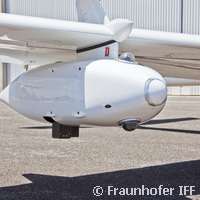Airborne imaging could revolutionise agriculture

An airborne camera capable of photographing the condition of certain crops over many acres of land could provide agriculturalists with the information they need to improve production. This is because, instead of simply recording an image of fields from above, the camera is capable of looking directly into the crops themselves.
The innovation, developed by researchers working at the Fraunhofer Institute for Factory Operation and Automation IFF in Magdeburg, Germany, has mainly focused on grapevines and maize. Specially designed software has been developed, capable of processing data from a hyperspectral camera, to more accurately analyse a crop's 'inner qualities'.
Hyperspectral imaging, like other spectral imaging, collects and processes information from across the electromagnetic spectrum. This means that the camera is able to scan the biochemical composition of crops, and deliver an overview of every constituent present.
The raw data from the camera is sent to the laboratory, where the concentrations of constituents relevant to the user are analysed. Newly developed software based on mathematical modelling is capable of recognising certain characteristic properties, and can filter these out of the raw data.
The hyperspectral camera has been trialled in some of the toughest agricultural terrain in the world: Australia. With dry salty soil and soaring summer temperatures, those making a living from the land here need all the help they can get. So far, the first series of measurements, taken in collaboration with the Australian Plant Phenomics Facility at the University of Adelaide, have been completed, and initial results look promising.
Indeed, the ability to 'look inside' these crops presents agriculturalists with new opportunities to increase crop yield. For instance, certain metabolites - products of metabolism - provide information on the quality of a plant's nutrition. Farmers could then concentrate on cultivating those plants that thrive particularly well under the prevalent climatic conditions, thus enabling them to irrigate their fields less, for instance.
The innovative camera could also help farmers to spot the onset of disease early, something that cannot always be picked up without the use of hyperspectral technology. An infested plant activates defence mechanisms, invisible to the naked eye, before an infection becomes outwardly visible, such as dead leaves and stalks. Previously, such tests required lengthy experiments in greenhouses.
A demonstrator of the system's use in greenhouses and laboratories will be on display at the BIOTECHNICA exhibition in Hannover, Germany from 8 to 10 October 2013.
Provided by CORDIS


















